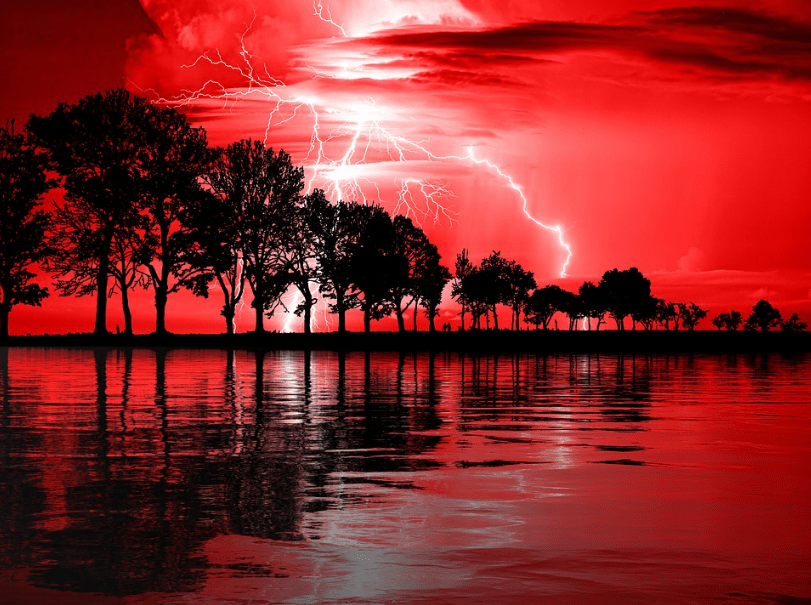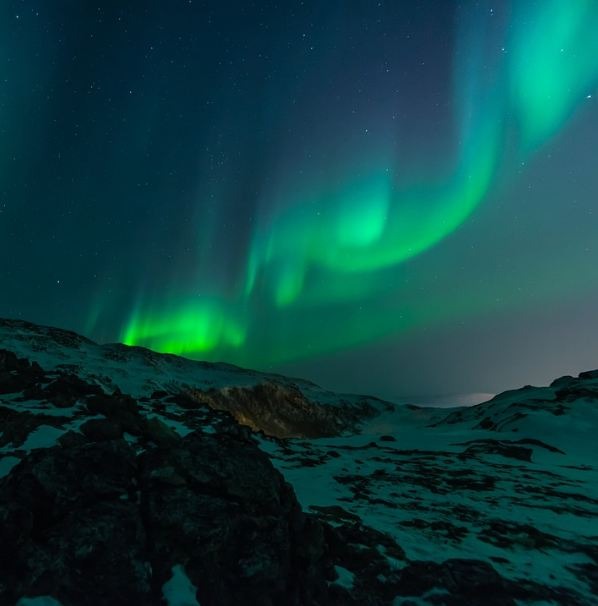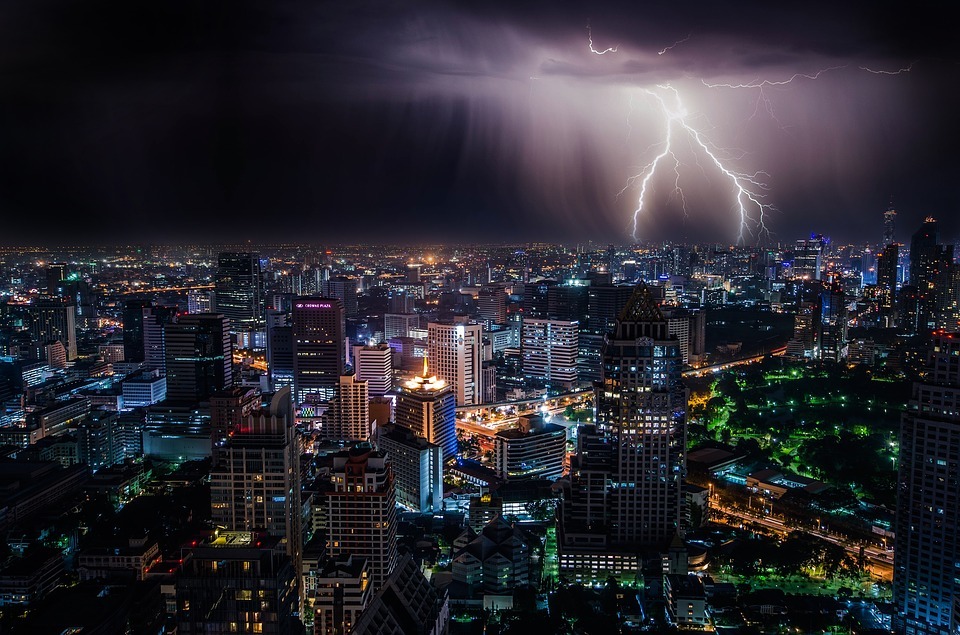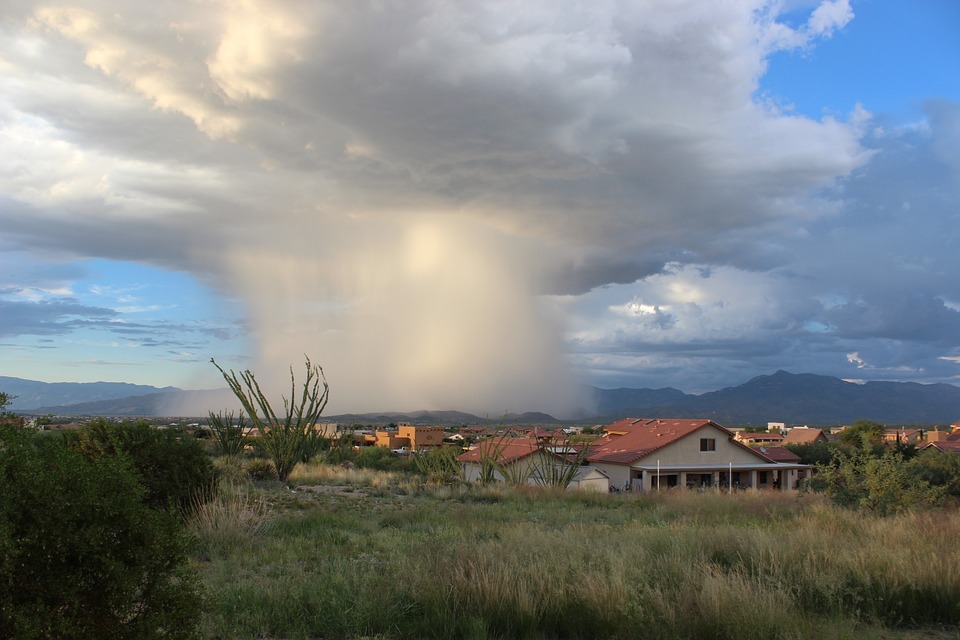What Triggers Red Sprites Lightning?
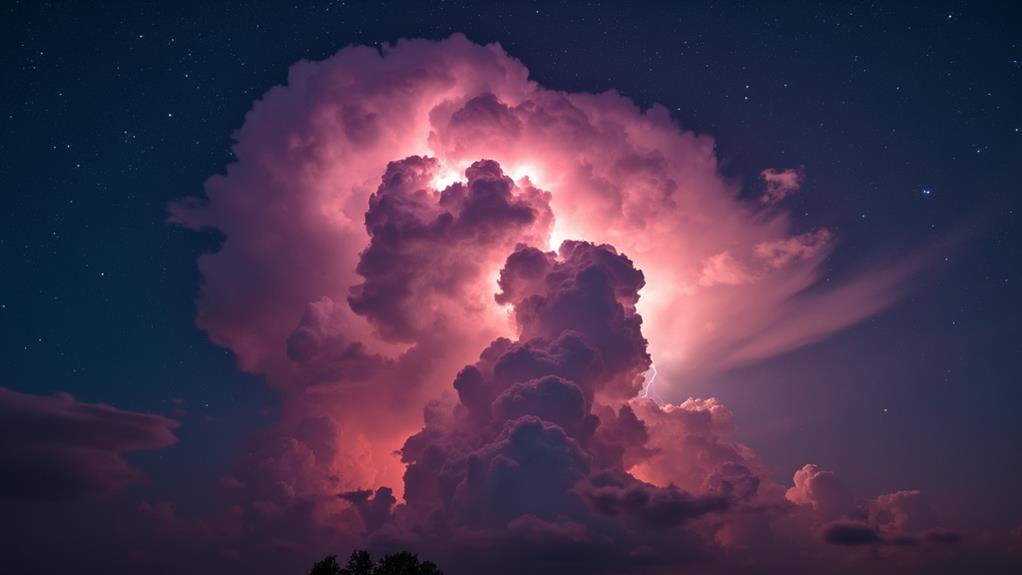
You're likely curious about what triggers red sprites lightning. Red sprites, those intriguing reddish-orange flashes high above thunderstorms, are sparked by strong positive lightning discharges. These discharges create intense electric fields, causing the ionization of gases at altitudes between 40 to 90 kilometers. The striking red color comes from excited nitrogen molecules in the upper atmosphere. Conditions like powerful thunderstorms and clear skies improve their visibility. If you're interested, learning more about the fascinating mechanisms and atmospheric conditions that contribute to this phenomenon could be quite enlightening.
Key Takeaways
- Strong positive lightning discharges are the primary trigger for red sprites.
- Electric fields generated by lightning strikes induce electrical breakdown in the upper atmosphere.
- High-altitude thunderstorms significantly increase the likelihood of sprite formation.
- Ionization of gases in the mesosphere, particularly nitrogen, causes the characteristic reddish hue.
- Favorable atmospheric conditions, like clear, dark skies, enhance sprite visibility.
Understanding Red Sprites
Red sprites are fascinating atmospheric phenomena triggered by strong positive lightning discharges from thunderstorms. When these powerful positive cloud-to-ground lightning strikes occur, they create intense electric fields in the upper atmosphere. You'll find red sprites typically appearing at altitudes between 40 to 90 kilometers (31 to 56 miles) above the storm clouds. They are a stunning example of optical phenomena in our atmosphere.
The formation of red sprites involves the acceleration of electrons into the mesosphere. As these electrons collide with atmospheric gases, they ionize them, producing the distinctive reddish glow you might observe. These electrical discharges are not just localized; they can be horizontally displaced by up to 50 kilometers (31 miles) from the original lightning strike, showcasing their vast area of influence.
Atmospheric conditions play a significant role in the occurrence and visibility of red sprites. Factors such as the presence of high-altitude clouds and specific humidity levels are essential. When these conditions align, the chances of witnessing these celestial spectacles increase. Understanding red sprites gives you insight into the complex interplay between thunderstorms and the upper atmosphere, making these phenomena even more intriguing.
Historical Background
The expedition to understanding red sprites began long before their official documentation in 1989. Before scientists at the University of Minnesota recorded the initial documented instances of these lightning sprites, there were anecdotal reports dating back to the late 19th century. Pilots and scientists often described seeing mysterious, lightning-like flashes above thunderstorms, but these sightings remained largely unverified until modern technology allowed for their capture.
Interest in these transient luminous events spiked in the 1950s and 1960s. Pilots and airliner crews frequently reported brief, eerie illuminations in the upper atmosphere, spurring curiosity and subsequent investigations. However, it wasn't until 1989 that researchers successfully captured these phenomena on film using a low-light video camera, providing the initial concrete evidence.
In 1994, Dr. Davis Sentman proposed the term "sprite" to describe their ethereal appearance, distinguishing them from other atmospheric phenomena. This terminology helped categorize and focus subsequent research efforts. Significant strides were made in understanding red sprites during the Sprites94 campaign and beyond, setting the stage for more detailed inquiries into their characteristics and triggers. These early revelations laid the foundation for our current understanding of these enchanting atmospheric events.
Formation Mechanism
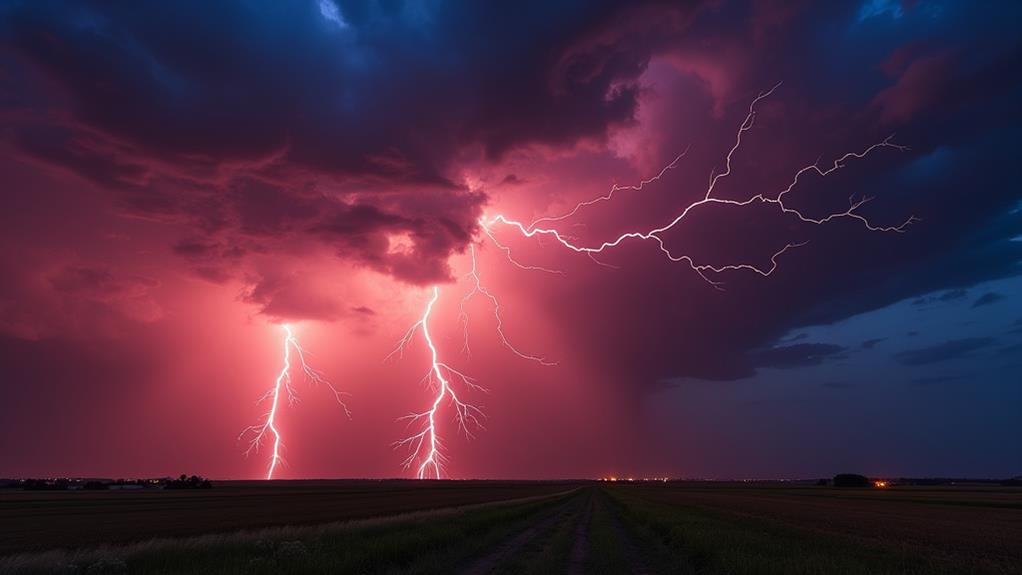
Understanding just how red sprites form starts with recognizing the powerful role of electric fields generated by lightning strikes. These strong electric fields, particularly from positive lightning strikes, create a brief but intense electrical breakdown in the upper atmosphere. At altitudes around 80 kilometers (50 miles), the breakdown voltage is greatly reduced due to the low pressure, facilitating electron avalanches that lead to the development of red sprites.
Red sprites often appear in clusters above thunderstorms, and they can be horizontally displaced by up to 50 kilometers (31 miles) from the original lightning strike's location. The quasi-static electric fields generated by these strikes are essential, as they sustain the conditions needed for sprite formation.
The reddish hue of sprites comes from the excitation of nitrogen molecules in the upper mesosphere. When these molecules return to their ground state, they emit red light, with these emissions dominated by nitrogen due to the quenching effects of atomic oxygen.
Researchers propose three main models to explain sprite production: Quasi-Electrostatic Field, Runaway Electron Breakdown, and Electromagnetic Pulse (EMP). Ongoing studies aim to validate these mechanisms by measuring the vertical electric fields involved in sprite generation.
Atmospheric Conditions
When diving into the atmospheric conditions that trigger red sprites, you'll find that strong positive lightning discharges play a fundamental role. These discharges generate intense electric fields in the atmosphere, which are indispensable for sprite formation. For sprites to occur, specific atmospheric conditions must be met, often linked with powerful thunderstorms.
High-altitude clouds, ranging from 40 to 90 kilometers (approximately 25 to 56 miles) above storm clouds, greatly impact the likelihood of sprite formation. These clouds influence the electric fields produced by lightning strikes, making them a pivotal factor. Furthermore, the presence of high-altitude clouds can improve sprite occurrence.
Here are some key atmospheric conditions for sprite formation:
- Powerful thunderstorms: These storms generate the strong positive lightning discharges necessary for creating intense electric fields.
- High-altitude clouds: They modify the electric fields and increase the chances of sprite formation.
- Dark, clear skies: Ideal conditions for observing sprites include minimal atmospheric disturbances to provide clear visibility to distant thunderstorms.
Visual Characteristics
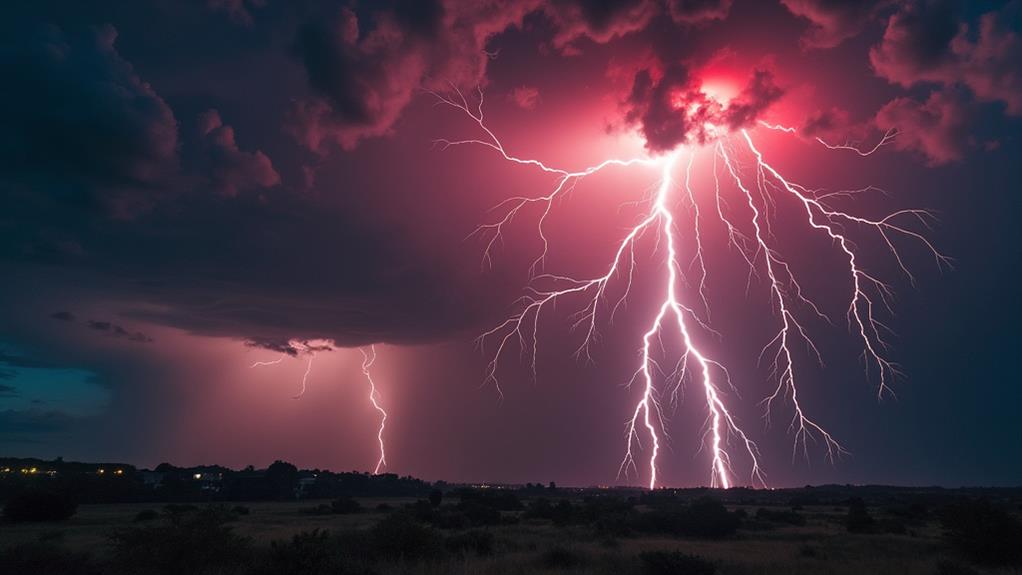
Gazing at the night sky during a thunderstorm, you might witness the breathtaking spectacle of red sprites. These electrical phenomena typically manifest as bright flashes of reddish-orange light against the dark sky, often adorned with bluish tendrils. The ionization of atmospheric gases, particularly molecular nitrogen, causes these brilliant optical displays. Red sprites can appear in multiple shapes, including tendrils, jets, and halos, and they're frequently observed in clusters above active thunderstorms.
These luminous events can last from mere milliseconds up to a few seconds, their duration influenced by the intensity of the associated thunderstorm activity. The size of red sprites can be astounding, sometimes spanning up to 30 miles (48 km) across. This makes them visible from high-altitude aircraft and even the International Space Station. The striking red color and other visual characteristics of sprites result from the excitation of molecular nitrogen in the upper atmosphere. The unique atmospheric conditions at their formation altitude favor red emissions, creating a mesmerizing spectacle above the cloud tops.
Understanding these optical characteristics of red sprites deepens our appreciation of these rare but stunning atmospheric events.
Observational Techniques
Capturing the elusive beauty of red sprites lightning requires specialized observational techniques. You're going to need a high-speed camera capable of capturing images at 100,000 frames per second. This kind of equipment lets you study the rapid phenomena in intricate detail. Long exposure photography is also crucial because red sprites can last from milliseconds to a few seconds, demanding sufficient light collection to make their faint emissions visible.
To increase your chances of success, you should aim for clear, dark skies and a good vantage point toward distant thunderstorms. Any stray light can easily wash out the faint emissions of sprites, making them difficult to see. Ground and aerial observational campaigns in places like Denmark and Armagh have proven effective for analyzing sprite behavior and frequency.
- Use high-speed cameras for detailed study.
- Employ long exposure photography for capturing faint sprites.
- Confirm clear, dark skies and distant storm vantage points.
Experts, such as Paul M. Smith, stress the importance of persistence and technique in both visual observation and photography. By following these guidelines, you'll be well-equipped to capture the mesmerizing phenomenon of red sprites lightning.
Scientific Research
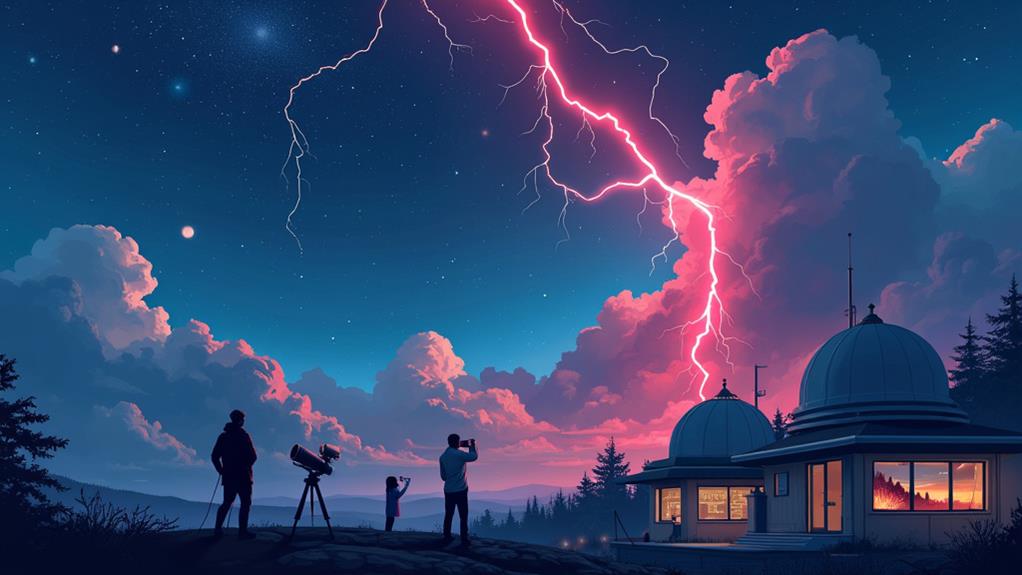
Scientific research into red sprites lightning has revealed that these fascinating phenomena are primarily triggered by strong positive lightning strikes. When a powerful positive lightning bolt occurs, it creates intense electric fields in the upper atmosphere. These electric fields induce a breakdown in the mesosphere, where sprites usually form at altitudes between 40 to 90 kilometers (31 to 56 miles). This breakdown results in stunning optical emissions that you can observe as red sprites.
Researchers have identified that sprites can occur up to 50 kilometers (31 miles) away from the original lightning strike, showing just how far these electric fields can reach. Scientists have examined diverse models to understand sprite formation, including the Quasi-Electrostatic Field model, Runaway Electron Breakdown, and Electromagnetic Pulse (EMP) effects from lightning. Each model provides valuable insights into the mechanisms behind these spectacular displays.
Observational campaigns like Sprites94, along with advancements in high-speed imaging technology, have greatly improved our understanding of sprites. These tools have allowed researchers to capture detailed images and analyze the specific conditions and dynamics that lead to sprite formation. Your curiosity about these electric phenomena is an indication of the incredible strides in scientific research, revealing the mysteries of our atmosphere.
Global Sightings
Since their initial documentation in 1989, red sprites have captivated observers around the globe. These mysterious flashes of light, often triggered by strong thunderstorms and powerful positive cloud-to-ground lightning strikes, are not limited to any one region. Global sightings have been reported in North America, Africa, Australia, and both South and Central America, showcasing their widespread nature.
Some key points to take into account include:
- Red sprites have been seen over both land and ocean, thanks to space shuttle astronauts.
- They can appear in clusters, with some storms producing multiple sprites.
- They occur in both temperate and tropical regions worldwide.
In North America, red sprites are commonly observed during the summer months when thunderstorms are most frequent and intense. The variability of atmospheric conditions plays a critical role in the frequency and appearance of these lightning strikes. For instance, certain storms might produce numerous sprites, while others might not generate any at all.
Extraterrestrial Occurrences
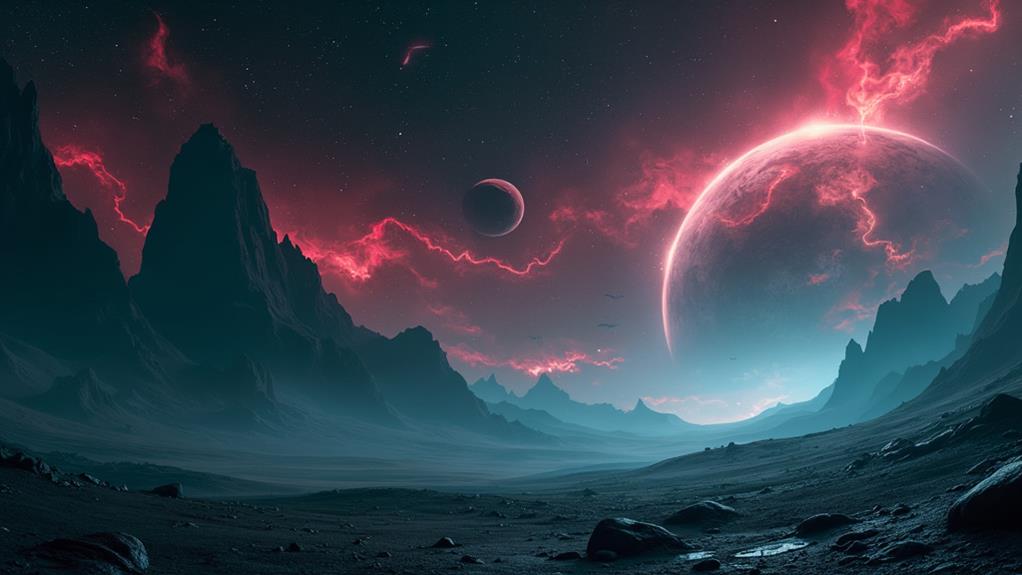
While red sprites have fascinated observers on Earth, their occurrence isn't confined to our planet. Scientists have confirmed that these intriguing electrical phenomena also happen in the atmospheres of other celestial bodies. For instance, NASA's Juno spacecraft detected sprites and elves in Jupiter's atmosphere in 2020, broadening our understanding of extraterrestrial electrical phenomena. These revelations indicate that the atmospheric conditions on Jupiter are ripe for the formation of sprites.
Ordinary lightning has been a known weather phenomenon in Jupiter's atmosphere since 1979, suggesting that similar electrical processes might be occurring on other gas giants, such as Saturn and Venus. In 2011, theoretical simulations conducted by Tel Aviv University demonstrated that Jupiter's atmospheric conditions could indeed support the formation of red sprites. This research underscores the possibility of sprites being a common feature in different extraterrestrial environments.
Further Reading
Curiosity about red sprites doesn't have to end here. There's a wealth of information available if you're enthusiastic to explore deeper into the phenomena of sprites and elves. These fascinating atmospheric events, triggered by strong positive lightning strikes, continue to captivate scientists and enthusiasts alike.
To expand your understanding, consider exploring the following resources:
- Research by the University of Alaska: Their studies investigate the intricacies of low-frequency perturbations and how they influence the formation of sprites.
- Space Missions and Observations: Satellite data offers unique insights into upward flashes and the electric fields that reach altitudes of 40 to 90 km, vital for sprite and elf formation.
- Technical Papers on Lightning Flash Dynamics: These documents explain the brief, sub-10 millisecond electric fields that initiate sprites, providing a detailed look at the mechanisms behind these luminous events.
Frequently Asked Questions
What Causes Red Sprite Lightning?
You might wonder if red sprite lightning is just another common lightning phenomenon, but it's not. It's a stunning nocturnal event caused by atmospheric electricity. When strong electrical discharges from thunderstorms reach the upper atmosphere, they create intense electric fields. These fields ionize gases, resulting in transient luminous events. This fascinating process usually occurs between 40 to 90 kilometers above Earth, making red sprites a unique and rare sight.
Is Red Sprite Lightning Rare?
Yes, red sprite lightning is rare. Sprite frequency is low due to the specific atmospheric conditions needed for their formation. They occur as electrical discharges above thunderstorms, typically during intense lightning phenomena. Observational challenges add to their rarity, as red sprites are brief and often hidden by clouds. Despite this, high-altitude aircraft and space stations have improved our ability to document these elusive events.
What Weather Is Associated With Red Sprites?
Have you ever wondered about the weather linked to red sprites? These incredible electrical discharges are tied to specific atmospheric conditions and thunderstorm activity. They appear at high altitudes, triggered by intense storm electrification. Red sprites are more common during certain seasons and in specific geographical areas. Their occurrence is influenced by altitude effects, with stronger thunderstorms increasing their chances. Understanding these factors helps demystify their seasonal occurrence and geographical distribution.
What Is the Rarest Lightning Color?
The rarest lightning color is purple. You might see it during purple lightning events, a unique blend of red and blue emissions. While blue lightning phenomena, green lightning sightings, and yellow lightning types are more common, purple stands out due to its fleeting nature. Orange lightning occurrences and white lightning characteristics are typical, but purple lightning's specific atmospheric conditions make it a rare and spectacular sight to behold.

